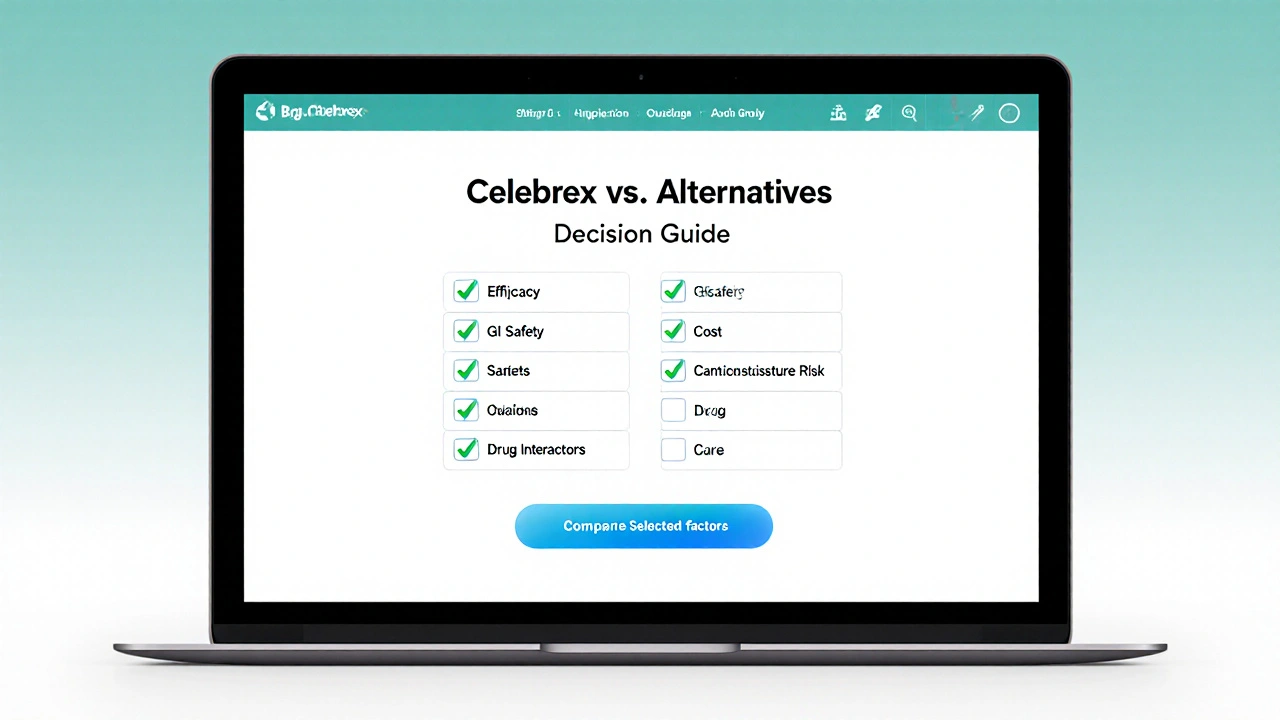COX-2 Inhibitors Comparison – Choose the Best NSAID for You
When looking at COX-2 inhibitors, a selective class of non‑steroidal anti‑inflammatory drugs that block the cyclooxygenase‑2 enzyme to reduce pain and inflammation while sparing the stomach lining. Also known as COX‑2 selective NSAIDs, they have become a go‑to option for many people dealing with arthritis, post‑operative pain, or chronic back issues.
One of the most talked‑about members is celecoxib, the generic version of Celebrex that offers once‑daily dosing and a reputation for lower gastrointestinal side effects compared with traditional NSAIDs. It’s often the first drug doctors consider when a patient needs strong pain relief but wants to avoid ulcer‑type problems. Other selective agents like etoricoxib or the now‑withdrawn rofecoxib follow a similar pathway but vary in dosing frequency, potency, and cost.
All of these drugs belong to the broader group of NSAIDs, medications that inhibit cyclooxygenase enzymes to lower inflammation, fever, and pain. While traditional NSAIDs hit both COX‑1 and COX‑2, the selective versions aim to spare COX‑1, which protects the stomach lining and platelet function. This distinction creates a trade‑off: reducing gastrointestinal risk often brings a higher cardiovascular risk, the potential for heart attacks, strokes, or blood clots associated with some COX‑2 inhibitors. Understanding that balance is key when you compare options.
So how do you pick the right drug? First, think about the condition you’re treating. For acute flare‑ups of osteoarthritis, a short course of celecoxib may give you relief without the stomach irritation you’d see from ibuprofen. If you have a history of heart disease, you’ll want a drug with a lower cardiovascular profile – many clinicians prefer naproxen, even though it’s not COX‑2 selective, because its heart risk is comparatively modest.
Second, consider dosage convenience. Celecoxib’s 200 mg once‑daily pill beats a three‑times‑daily regimen for many patients, boosting adherence. Third, look at cost and insurance coverage. Generic celecoxib has become cheaper in recent years, but some newer agents still carry premium pricing, which can be a barrier for long‑term therapy.
Another practical factor is drug interactions. COX‑2 inhibitors can boost blood pressure, so pairing them with antihypertensives may require closer monitoring. They also interact with anticoagulants like warfarin, raising bleeding risk despite their COX‑1 sparing nature. Always discuss your full medication list with a pharmacist or doctor before starting.
When you compare these drugs, you’ll notice three recurring themes: effectiveness, safety (both GI and cardiovascular), and convenience. The best choice often hinges on which of those matters most to you. If stomach protection tops your list, a selective inhibitor like celecoxib shines. If heart health is your primary concern, a non‑selective NSAID with a proven lower cardiovascular risk profile might be safer.
Below you’ll find a curated set of articles that dive deeper into each of these angles – from detailed side‑effect tables to real‑world pricing guides and tips on monitoring your health while on therapy. Whether you’re a patient trying to understand your prescription or a clinician weighing options, the collection offers practical insights you can act on right away.
Ready to explore the specifics? Scroll down to see side‑by‑side comparisons, dosing tricks, safety checklists, and cost‑saving advice that make the decision process a lot less guesswork.

Celebrex (Celecoxib) vs. Common Alternatives: Pros, Cons, and How to Choose
A detailed comparison of Celebrex (celecoxib) with common NSAID alternatives, covering efficacy, safety, cost, and how to choose the right option.
- Health and Wellness (55)
- Drug Information (37)
- Pharmacy Information (19)
- Medical Conditions (15)
- Supplements (4)
- Travel Health (2)
- Diabetes (2)
- Mental Health (2)
- Heart Health (1)
- Fertility (1)
-
Lithium vs Other Mood Stabilizers: Efficacy, Safety and Practical Comparison
25 Sep 2025 -
Introducing Hound's Tongue: The All-Natural Dietary Supplement for a Healthier, Happier You!
29 May 2023 -
DVT and Dehydration: Why Proper Hydration Reduces Blood Clot Risk
22 Oct 2025 -
Buy Online Cheap Generic Seroquel - Safe Guide & Price Comparison
6 Oct 2025 -
Phenazopyridine & Exercise: How to Stay Active When You Have a UTI
21 Oct 2025

1.10.25
Alistair Mukondiwa
16